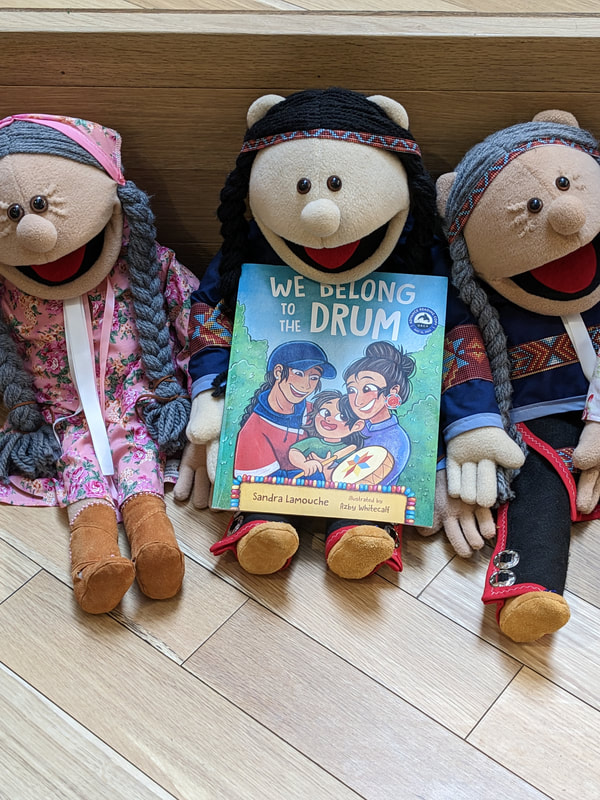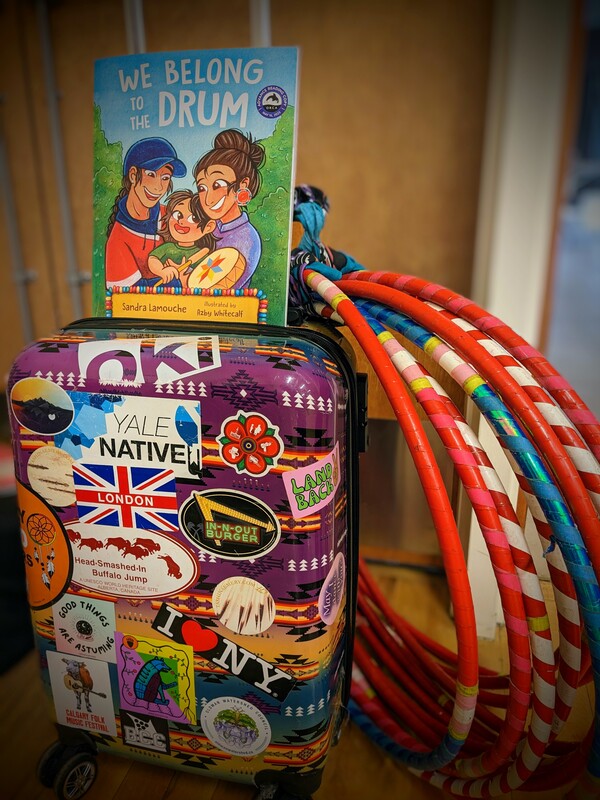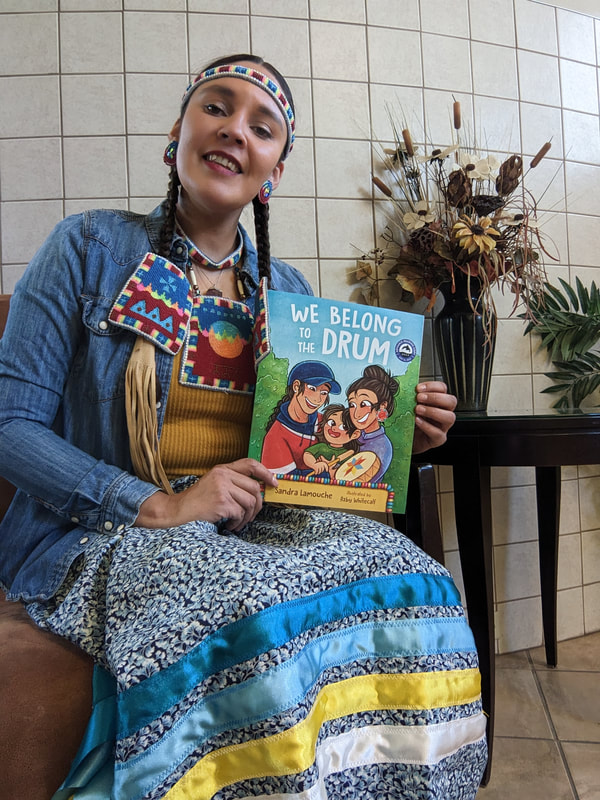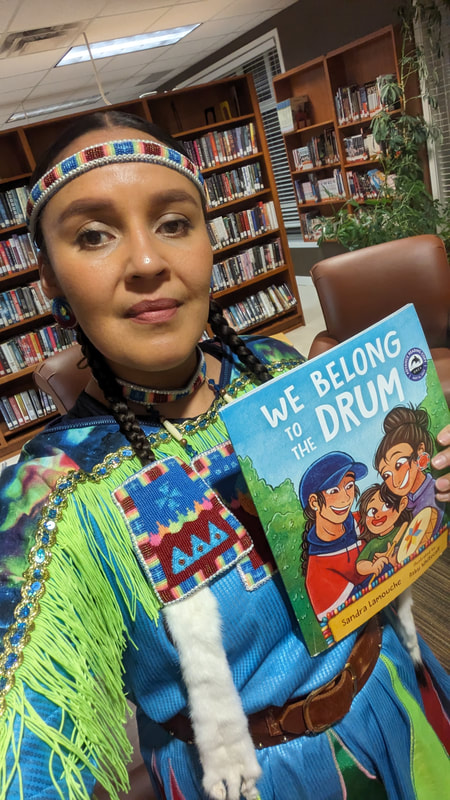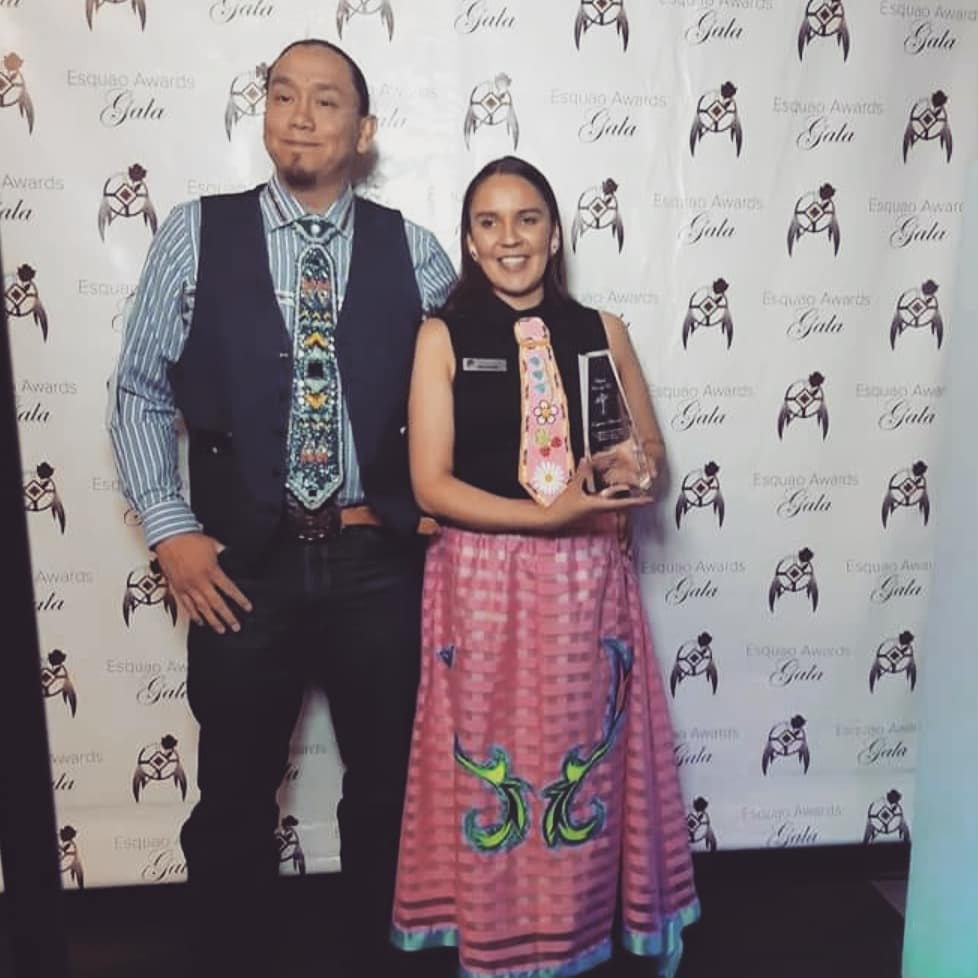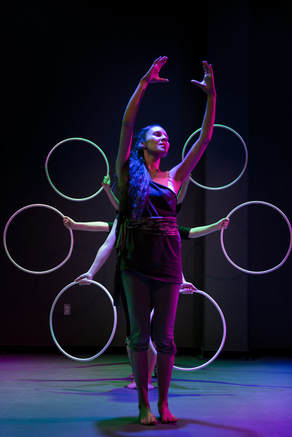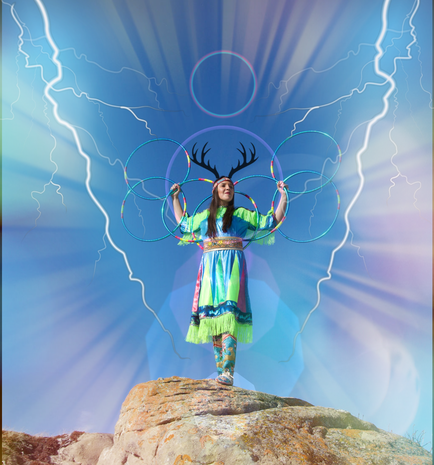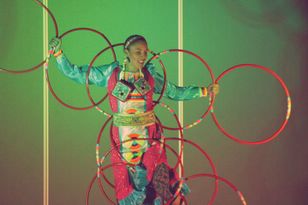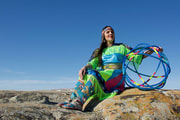|
11/1/2023 0 Comments What does it mean to belong?Brene Brown says that 'belonging does not equal fitting in' in order to belong we do not need to change who we are. When we are accepted just the way we are then we truly belong. This is my first children's book and was published in May 2023. The story itself however has been a long time coming. It is inspired by the true story of how my oldest son (a teenager now!) found belonging in daycare as one of the only Indigneous children who attended there. A transformational experience for both of us and a story that still inspires me in the work I do today. If a child who is learning to walk and talk knows whether they belong or not, then I know that sharing culture, knowledge, and traditions is invaluable in the world. I was able to to share our story at a recent keynote presentation for a global education conference and hope to continue to encourage more people to learn about creating spaces that promote true belonging, not 'fitting in'. Having worked in the education system for over a decade (and recieved an award for my work) I know that belonging is an essential part of the curriculum for younger grades. Some of the performances and speaking engagements I have done so far in 2023 include the Calgary Public Library, South Country Fair, virtual events, libraries, schools and community events across Alberta. Children's Literature has given "We Belong to the Drum" a 5/5 rating!
"This title exemplifies the importance of inclusion and belonging and offers a sense of community, whether it be with family, at cultural events or at daycare. The illustrations are bright, vivid, and joyful and they serve as a wonderful supplement to the text. Recommended for school, home and public libraries." - Canadian Children’s Book News (https://bookcentre.ca/canadian-childrens-book-news) *You can purchase my book here.
0 Comments
COVID 19 has created a world of imbalance in the lives of many. Physical connection is a natural and nurturing aspect of human life that we are missing out on during this time of social distancing. When babies are born the first thing we do is hold them in arms to provide skin to skin contact. The safety recommendation to stay home and work from home also means a decline in physical movement. Emotionally we may be dealing with more stress and anxiety because so much is yet unknown to us and so much has changed in a short time. We may be separated from our emotional support system and lack the relationships we are used to. We may be experiencing grief and fear. Our spiritual sense of resilience, strength, hope is being tested. As Indigenous people we rely on our elders and ceremonies for healing, both of which may only be available virtually or by phone. Mentally we may be dealing with negative thought patterns more than usual. We may be dealing with fear and confusion with all the information and opinions in the news. One of the big concerns after the physical impact of the virus is the mental health impacts of a pandemic, which can last up to five years for some. One thing we can do now to mitigate these effects is to build resilience through connection and coping skills. I created this video to hopefully help with building resilience, as well as, lessen the effects this global pandemic may be having on us. Please stay safe and take a moment to ground yourself, breathe, and live in the movement... **This is not intended to be a substitute for professional advice, diagnosis or treatment.** In May 2019 I was honored to receive an Esquao Award from the Institute for the Advancement of Aboriginal Women for Leadership in Education. It was difficult to wrap my head around this achievement because so often in Indigenous education we are breaking new ground with everything we do so it takes a lot of courage and persistence. Things that a hoop dancer would be well prepared for. One of the lessons I was taught was that the hoop represents a challenge in life, the more hoops a dancer uses reflects how they handle challenges in their life. The more you go through a hoop the better you become as a dancer, the same thing goes for the challenges in our life, the more we go through those challenges the stronger and wiser we become. So my message would be to go through each hoop that life gives you! Each one is an opportunity for growth.
Read my acceptance speech here: "First of all I would like to thank the creator, my friends and family, and those who nominated me, and the organizers at IAAW. I am born of missing and murdered Indigenous women. I am born of residential school survivors and Metis Resistance. I am born of colonization and assimilation. I am born of survivors and warriors. I am born of culture carriers, storytellers, and medicine people. I carry the wounds and the resilience of my family and ancestors. I want to share a story about my oldest son, Matt. When he was in daycare he would cry every time we left. One day another mom brought in her child’s favorite music, so I thought I would bring in a powwow CD. The daycare was so excited to have this that they started exploring drum music from around the world, it wasn’t until the native drum played that my son took notice. He recognized the big drum from all other drums. He went to a toy drum in the room, called his friends over and showed them how to drum. They watched powwow videos on youtube, and he exclaimed ‘mommy – daddy’ it was the first time they heard him speak. The next morning he grabbed his own shoes and coat and went to the door. I didn’t have to fight with him. When we dropped him off he no longer cried. His culture allowed him to feel safe, to share his knowledge, and to be happy and successful. This is the reason that I do this work, this is my why." Hiy hiy, thank you! 9/15/2018 2 Comments Infinite Wisdom of the Hoop DanceThe hoop dance represents everything in life, and the hoops themselves represent the challenges in our life, thus the dance can be used as lesson as well for any situation in life. As a hoop dancer the lessons of the dance are always unfolding in my life in different ways, often this depends on why and where I am performing, who I am teaching, etc. This is one of the reasons I began this blog in the first place. My hoop dance teacher shared that the shapes a dancer makes are manifested to the audience in ways they need to see them, so each time you watch the hoop dance a new understanding may emerge. After a school performance a teacher asked if her students could say what shapes they saw, and if I could tell them whether they were right or wrong. I shared that it is up to the spectator to decide what they saw, it is the 'manitous' (spiritual beings) who present themselves to people in certain ways. This is a reflection of the limited ways society sometimes views the world around us - such as being black and white, right or wrong, and good or bad. The hoops on the other hand represent continuity- constant movement and constant change. Because the hoop dance creates different understandings the more it is performed and viewed, it becomes a symbol of infinite wisdom, and this is evident in the shape of the hoop itself, a shape with no beginning and no end...
Photo Credit: Kyle Fowler Photography Have you ever thought about the power of a name? I grew up in Slave Lake, Alberta, a name that comes from the Slavey people a name of European origin that is derogatory, or at best misappropriation. The name 'Slavey' refers to people who call themselves Denѐ, which translates simply to 'people'. Their are stories like this all over Turtle Island...
The name my parents gave me 'Sandra' means defender of man or helper of humanity, which is actually very appropriate if you know me. My last name Lamouche, meaning 'the fly' was given to my great grandfather because he was a hard worker, it was a nickname. Later, the missionaries told him it was because he was so insignificant, like a fly. My Blackfoot name, Itamspiakii, translates to Happy Dancing Woman and comes from the deer family. This name has many meanings- It is a reminder to be happy and think positive. It is motivation and encouragement to keep dancing, to not give up. It carries the meaning of what a woman is to Indigenous peoples, including culture carrier and life giver. The deer is a graceful and gentle creature, which I try to embody in my dance and everyday life, this also connects me to this land, and to the natural world. This name carries so much guidance, wisdom and resilience. At one time all over North America we only had our Indigenous names, which were not only spiritual and sacred, but they were also inspiring and empowering. Names could be passed on from your relatives and ancestors, with the expectation that you live up to that name and the greatness and achievements of the person who carried the name before you, as is the case with my two sons. Your name could change over your lifetime, therefore your identity could change. Through your achievements and actions could earn an appropriate name. In essence, the family or situation you were born into did not predict your path in life, you could persevere and overcome, you could change your life and your resilience was honored. The name of the first hoop dancer in the Ojibway story is 'Pukawiss' which means the disowned one, they say nobody remembers his real name. Despite being disowned Pukawiss creates the hoop dance and makes a name for himself (no pun intended) as a renowned artist, storyteller and performer. His actions speak louder than his name and his legacy remains a powerful part of Indigenous identity to this day. Indigenous names are an important part of building resilience. "Resilience is the process of adapting well in the face of adversity, trauma, tragedy, threats or significant sources of stress — such as family and relationship problems, serious health problems or workplace and financial stressors. It means "bouncing back" from difficult experiences (source)". In Canada, Indigenous peoples were systematically given European names through assimilation policies, in some cases, such as residential schools Indigenous people were sometimes given numbers to replace their names. Reclaiming Indigenous names does not only build resilience it also a step towards reconciliation. As the Truth and Reconciliation Call to Action #17 states: "We call upon all levels of government to enable residential school Survivors and their families to reclaim names changed by the residential school system by waiving administrative costs for a period of five years for the name-change process and the revision of official identity documents, such as birth certificates, passports, driver’s licenses, health cards, status cards, and social insurance numbers" Indigenous peoples are reclaiming Indigenous names all over, from personal names to community names and names of nations as an important act of reconciliation and resilience, and also an important way to take back our power as people and nations, for healing, self-determination and sovereignty. In March 2018 I celebrated ten years of sobriety. A decade of living drug and alcohol free as an adult. This decision was a direct result of learning to hoop dance. As I started on this journey of dance and culture I was told that if I participated in my culture I was representing my culture to others, I would be a role model. I believe that all those who practice their culture, dance, song, ceremony, arts and storytelling are all powerful role models. When you share your culture you are an advocate for your people. Others look towards you as a conduit for connecting to culture.
In the story of the hoop dance, because it is a healing dance, it is a great responsibility to become a hoop dancer. To represent the circle of life, you are representing life and all that it means to grow, thrive, and live in wellness. In the original ceremony of the hoop dance, the hoop dancer dances with the hoop and returns it to the person seeking healing as a message that they are responsible for their own healing. Thus, the hoop dancer, who cares for their own hoops, is responsible for their own continual healing. This includes spiritual, physical, emotional and mental well-being, as the symbol of the hoop encompasses the four directions and teachings of the Medicine Wheel. Indeed, one of the hoop dance teachings is that how many hoops you can handle, reflects how you handle the different challenges within your life. For those who strive to be culturally grounded and focused artists our practice reaches far beyond the stage, screen, or canvas into everyday life, and everyday practices of self-care, taking care of our body, listening to our emotions, monitoring our thoughts, our relationships, and wellness. When you are an artist, when you share your culture, when you are a role model it is a great responsibility. To show the sacredness of an ancient culture you must also practice the the teachings. When we choose to practice these teachings we are showing respect to our culture and to our teachers. To respect ourselves is to also respect the culture we carry, our ancestors who carried it in the past, and the future ancestors who will carry it forward long after we are gone. What the past ten years have taught me is that healing is not a life-long journey, but life is a healing journey. We are all healing from something, we are all imperfect and this is part of the circle of life. Photo Credit: Eugene Tapahe
I distinctly remember the university course I took, where it was stated that in the social hierarchy Native women are at the very bottom, below every other race and gender. This summer, this event, helped to change that... Following my journey to the World Championship Hoop Dance Contest, a male dominated title, I wrote a blog to honor the role of women and advocate for balance and equality in what society values as important, valid and praise-worthy. My routine for that event was created to honor the strength and gifts of women. I titled that blog "Women in the Circle" which you can read here. This call for gender balance was shared by others. This August a call was made to all Women Hoop Dancers to participate in the first and only event of its kind at the Intermountain All-Woman Hoop Dance Contest in Salt Lake City, Utah. Organized by Saanii Atsitty and hosted by This is the Place Heritage Park. For myself, this was highly anticipated event. I began asking questions and getting to know Saanii, which was a great relief, and made all the difference for me wanting to attend. Once I read the official rules for the event I was even more excited. Instead of using "showmanship" as one of the judging criteria, they used Grace/ Elegance. I was literally in shock and awe. I was floored by how changing one word can change the whole game. I felt for the first time that my style and skills were reflected in the contest rules! According to Dictionary.com the Word Origin and History for showmanship (1859) comes form the word showman "one who presents shows". Breaking that word down, "show" means an exhibit, display, entertainment, or spectacle; and "man" adult male person, obviously; the ending "-ship" denoting skill. Taken all together this translates to 'display of adult male skill'. This does not reflect my style as a female hoop dancer. Also, the word 'show' does not reflect my practice as a hoop dancer, for me it is more than a show, I also embrace the story and teachings behind the dance. One example is being drug and alcohol free for almost ten years. At the Intermountain All-Woman Hoop Dance Contest the words used as judging criteria were Grace, meaning "elegance or beauty of form, manner, motion, or action" and Elegance as refinement. This was definitely more true to who I am as a female hoop dancer, who I always have been, and who I always will be, as an Indigenous woman. Of course, not saying all women feel this way, or would agree, or should be graceful and elegant, this is just my personal feeling. Women can be whatever they want and should not been ashamed of who they are naturally. This one word started to make me think of how unfair this would make the contest for a male hoop dancer, how would they feel having to be graceful and elegant? How awkward would they feel trying to show grace and elegance? This got me thinking of the larger society, and how many more rules and words out there that favor male characteristics? I feel that the world is changing, returning to balance, supported by seemingly small acts by courageous women. I feel that a single word, broken down like this can create change in how we see the world, how we define ourselves and others. One word can change the rules, change the game, and change how we see success. Hiy hiy/ Thank you, Saanii Atsitty, and all the committee of the Intermountain All-Woman Hoop Dance Contest, for giving me a sense of pride and hope, as an Indigenous woman and as a hoop dancer. I am honored to have the privilege of being the first adult woman champion at this event! 3/8/2017 1 Comment Women in the Circle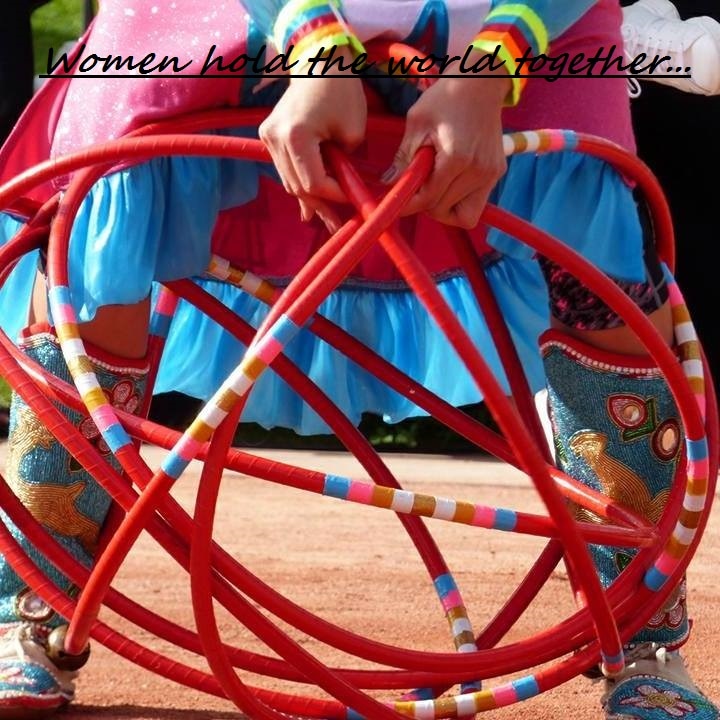 Miwasin Iskwewak Kisikaw!- Happy Women's Day! As many of you probably know today is International Women's Day! A day to recognize and celebrate the life-givers, home makers, culture carriers, water protectors, knowledge holders, ceremony keepers, earth warriors! And, so much more! My recent hoop dance at the Heard Museum 'World Championship Hoop Dance Contest' in Pheonix, Arizona was created to represent myself, as a women, who holds many of the roles mentioned above, as well as, to honor the many roles of women that go unnoticed and are undervalued in our society today. When we are in ceremony the circle is often divided into a women's side and a men's side, representing balance, equality, and unity of male and female gender roles. The hoop dance has historically been a male dominated dance, which is a critique some have towards the World Championship Hoop Dance Contest. Although, I have never heard teachings that explicitly say only men are allowed to hoop dance. I do not believe that women need a separate category at the World Championships. What I do wish to see is that women are valued, respected, and honored for what they bring to the circle. I think it is important to retain that balance, equality, and unity of different gender roles which had made our ancestors such healthy and strong people, as well as, their family, community and nations! Hiy-hiy! Thank you! Watch my World Championship Hoop Dance performance here: 10/16/2016 1 Comment Circling TogetherThe title for this post comes from the song by Buffy Sainte-Marie that I first heard at the 2016 Juno Awards, Indigenous Showcase. This is also where I first heard songs from Cris Derksen's Orchestral Powwow album. Hearing Buffy's song "We are Circling" I immediately thought it would make a great hoop dance song. Since then I have been dancing to "We are Circling" as well as, Cris Derksen's "Intertribal Happy Feet". Together these two Nehiyaw Iskwewak (Cree Women) provide an image of coming full circle for me. From starting with Western dance styles (tap, ballet, etc.) and later becoming a hoop dancer and return to Western dance styles (contemporary), with an infusion of Native dance and movement practices. These two recording artists reflect how we as Indigenous people are circling together today through two worlds and two paradigms. Although they may collide, they also overlap. When these worlds overlap we can find the space of togetherness, and find ourselves circling together.
The video above features these two songs (among others) during our dance demonstrations at our First Nations Dance and Art Summer Camp in July 2016. I started Hoop Dancing in Lethbridge, Alberta over a decade ago, so teaching Hoop Dance in Lethbridge was also coming full circle for me in a physical sense. The summer camp also represented coming full circle in my experience with Contemporary Indigenous dance and performance. Much of my experiences have been with International groups of dancers and/ or artists from different nations, and backgrounds. However, they were always experienced or trained in both traditional and contemporary forms of art, history, and knowledge (Indigenous and Western). This experience has given me the opportunity to experience a wealth of knowledge from people of different nations including Anishnaabe, Cree, Blackfoot, Mohawk, Maori, etc. I was able to use these experiences in our summer camp, which included a diversity of youth, representing nations such as Blackfoot, Cree, Mohawk, Navajo, and Maori. It felt like I was bringing together a new circle of Indigenous dancers. Like throwing a rock into a lake, creating a ripple effect. Even though we may not always see each other, wherever we go, wherever we dance, we are carrying the experience and knowledge of our mentors, friends, family with us, always. We are circling together. In May 2016 I was invited to return to Calgary for the Puppet Power 2016: Connecting Generations conference. I was asked to do an 8 minute presentation on the theme of Elder Wisdom. I spent months worrying, contemplating, and revisiting how to synthesize the immensity that is elder wisdom from the perspective of the hoop dance into 8 short minutes. After all, the hoops only encompass, ALL OF CREATION! An intimidating task for anyone, and I certainly do not consider myself an expert on the topic of elder wisdom. Dance on the other hand, I hope I have learned some things over the past decade, especially after years of researching, interviewing, and working closely with several senior artists as mentors in dance and performance. Although, I was told that it takes ten years to become competent in the dance and twenty years to master it. So, according to these standards, I still have a long way to go… Which reflects what elders often say, ‘I don’t know anything’ or ‘I am still learning’ or ‘I only know what I have experienced’ are common insights I have heard from different elders. This is true. A person can only know what they have experienced or been taught. However, our elders have had significantly more experiences than us. This is a key aspect of Elder Wisdom.
When I began learning the hoop dance, Jerry First Charger, my teacher and master hoop dancer, shared that each hoop represents a challenge in your life. The more that you go through the hoops represents how you handle the challenges in your life. As you continue to hoop dance, you get better, faster, stronger. The same thing goes for challenges in life, the more you go through those challenges, the stronger and wiser you become. Most people see the beauty of the hoop dance, but what people often fail to see, as the late Basil Johnston wrote, is the struggle within the dance. As the hoop dancer transitions from one shape to the next, they struggle to maneuver through the hoops. So the hoop dance represents the beauty in life as well as the struggle in life. So in it's entirety it represents the Beautiful Struggle of Life. This is where elder wisdom comes in. Our elders having gone through significantly more experiences than us, and have had to go through more hoops than us. They have overcome many more struggles than we can imagine. I think this is evident if you have ever sat with an elder to listen to their life story. For me, this sums up the true meaning of Elder Wisdom, having gone through the beautiful struggle of life long enough, having survived and overcome the many challenges, successfully navigating through life’s hoops to be able to know how to successfully navigate the challenges life throws your way. To share that Elder Wisdom with the youth to guide them on their journey through the Beautiful Struggle of Life is how we Connect Generations. “Wendy's Highlight: I was moved by Sandra Lamouche's raw and honest hoop dancing wisdom - particularly as she caught her breath to say the struggle of accomplishing the dance itself is a reminder of the struggle of life and the importance of building resiliency.” - WP Puppet Theatre Newsletter |
Nehiawsko Pikiskwew'Cree Woman Speaking' is a space to share my voice. My goal is to spread awareness and share wisdom as I learn and grow as a dancer, choreographer, and woman. My passion is to show the healing power of dance and culture. I love learning from elders, experience, and research and being able to synthesize Native and non-Native ways of knowing! Archives
November 2023
CategoriesAll Cara Mumford Cree Hoop Dance Idle No More Indigenous Dance International Women's Day 2017 Life Givers Missing And Murdered Aboriginal Women Native Hoop Dance Native Women Nehiyawak Reconciliation Resilience Rulan Tangen Sacred Hoop Sisters In Spirit Stolen Sisters Sugarray Robinson When It Rains World Championship Hoop Dance Contest |
